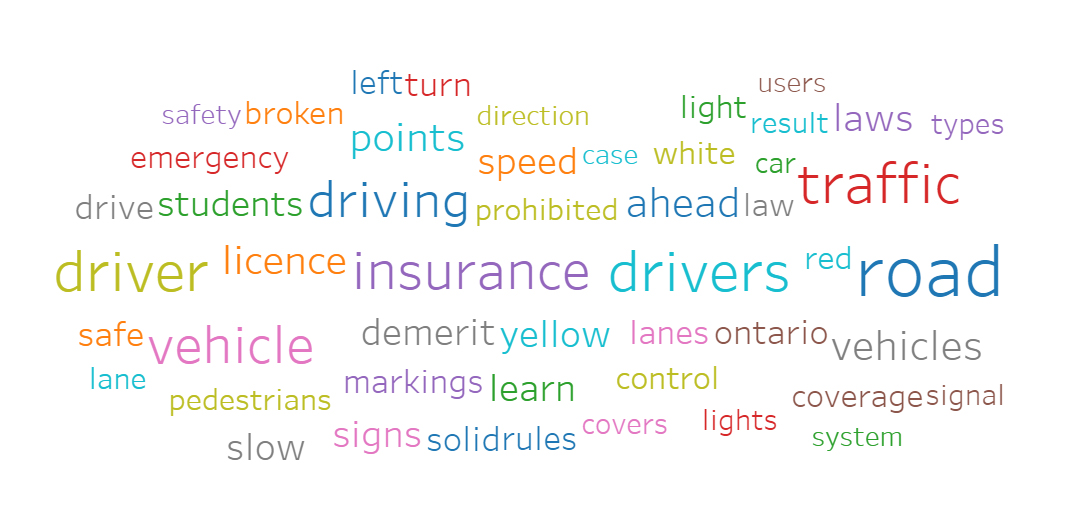The purpose of the Rules of the Road module is to help students develop the knowledge and skills required to become safe and responsible drivers.
Module Objectives
The Rules of the Road module's main objective is to teach students the importance of traffic laws and regulations and provide the knowledge and skills required to become safe and responsible drivers. This module also teaches about road users and their rights.
Know The Road Users:
- Drivers
- Pedestrians
- Cyclists
- Motorcyclists
- Horse riders
- People In-charge of animals, i.e., dog walkers
Learning Outcomes:
After successfully completing this module, students will acquire the following skills and knowledge:
- Students will learn about the rationale for traffic laws and regulations and how they contribute to road safety
- Students will learn about current road safety issues and how traffic laws and regulations address them
- Students will learn about the rationale for traffic controls devices in general and how they contribute to road safety
- Students will learn about impaired, distracted driving, aggressive driving and pedestrian safety
- Students will learn about speed, stopping distance, speed limit and penalties
- Students will learn about emergency vehicles
- Students will learn about the driver's licence classification and how to get the licence
- Students will learn about the importance of vehicle insurance and various types of insurance coverages
- Students will learn about the traffic laws and regulations in other jurisdictions
- Students will learn about municipal by-laws
- Students will learn about traffic control devices like signs, signals and markings
- Students will learn about various categories of traffic signs and roadway markings like regulatory, warning, informational and unique signs for roadworks
- Students will learn about the demerit points system
- Students will learn about the licence suspension and consequences
- Students will learn how the rules, standard safe practices of road users and informed decision-making contribute to safe and responsible driving
Ontario is the most populous province in Canada, with a diverse range of driving conditions and challenges. Whether you are a new driver or a seasoned veteran, it is essential to know and understand the rules of the road in Ontario to ensure safe and responsible driving. In this article, we will take a closer look at the key rules of the road in Ontario.
Speed Limits
One of the most important rules of the road in Ontario is to adhere to the posted speed limit. The maximum speed limit on highways is typically 100 km/h, while the speed limit on most urban and residential roads is 50 km/h. It is important to note that these speed limits are not a target and should only be exceeded in emergency situations.
Seatbelts
Another critical rule of the road in Ontario is to always wear your seatbelt. All occupants of a vehicle must wear a seatbelt, and failure to do so can result in a fine and demerit points on your driving record. It is also important to ensure that children are properly secured in appropriate car seats or booster seats based on their age and weight.
Distracted Driving
Distracted driving is a growing problem in Ontario and is responsible for a significant number of accidents each year. It is essential to avoid using your phone or other electronic devices while driving, as this can distract you from the road and increase the risk of a collision. Other forms of distracted driving, such as eating or grooming while behind the wheel, should also be avoided.
Impaired Driving
Impaired driving is a serious criminal offense in Ontario and can result in fines, license suspensions, and even jail time. It is essential to never drive while under the influence of drugs or alcohol, and if you plan to drink, make arrangements for a designated driver or use public transportation.
Yielding and Right-of-Way
Understanding who has the right-of-way is essential to safe driving in Ontario. When approaching a four-way stop, the first vehicle to arrive has the right-of-way, and if two vehicles arrive at the same time, the vehicle on the right has the right-of-way. When turning left, you must yield to oncoming traffic, pedestrians, and cyclists.
Turning
When turning, it is important to signal your intention to other drivers and to check your blind spots before making the turn. Left turns should always be made from the leftmost lane, while right turns should be made from the rightmost lane. It is also important to yield to pedestrians and cyclists when making a turn.
In conclusion, driving in Ontario requires a thorough understanding of the rules of the road. By following these rules and being a responsible driver, you can help ensure the safety of yourself and others on the road. Remember to always wear your seatbelt, avoid distracted and impaired driving, and be aware of yielding and right-of-way rules. Safe driving!
Keywords:

